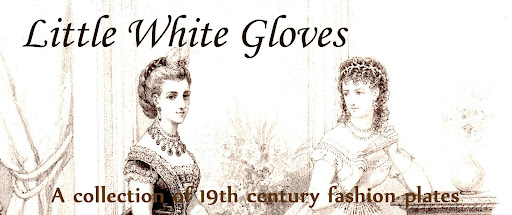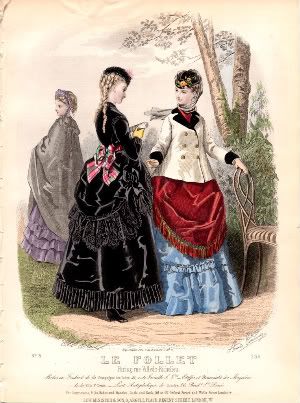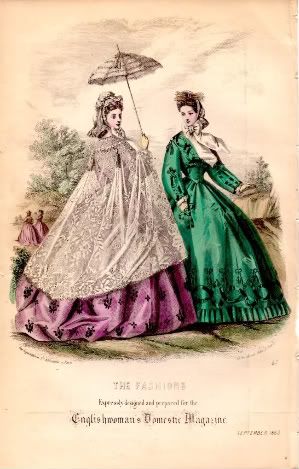Larger image
I have no idea what that chair is doing in the middle of a garden, but I am completely charmed by this print, randomly placed chair and all. This is beautiful scanned, but I wish you could hold the original because it is incredible. It’s when you look at the teeny delicate brushstrokes that give the appearance of silks and laces that you can see what amazing artists these lithographers were. It is a very commercial art, it is true, but a very beautiful one.
This is, at this time, my favorite fashion plate. I love the romanticism of this. The bold colors, rich textures. These ladies all have such wistful looks on their faces. Not in a damsel in distress way, as each of the three looks intelligent and capable, but like they are all longing for something better.
Unfortunately, I do not have a fashion description for this plate.
Purchased on ebay as a loose fashion plate, December 2010.
Wednesday, February 9, 2011
December 1863, Englishwoman’s Domestic Magazine, Dinner Dress and Walking Dress
Larger image
This sweet little plate is from the December 1863 issue of Englishwoman’s Domestic Magazine and features the sort of daintiness –ornate furnishings, ruffles, etc. – that only seems possible in the Victorian era. Especially the teeny, tiny waistline. I heard Barbie took a look at this plate and commented that the waistlines didn’t look possible even to her.
This plate did come with the original fashion description provided by Englishwoman’s Domestic Magazine:
Alas, no elegant “dentelle de yak” in this plate. I do wonder why they made the walking dress brown. It looks a bit drab next to the evening dress and the little girl’s dress, don’t you think?
There happened to be some very entertaining text on the other side of the fashion plate description page, which you can find here on my personal blog.
Purchased on ebay as a loose fashion plate in December 2010.
This sweet little plate is from the December 1863 issue of Englishwoman’s Domestic Magazine and features the sort of daintiness –ornate furnishings, ruffles, etc. – that only seems possible in the Victorian era. Especially the teeny, tiny waistline. I heard Barbie took a look at this plate and commented that the waistlines didn’t look possible even to her.
This plate did come with the original fashion description provided by Englishwoman’s Domestic Magazine:
DINNER or EVENING COSTUME. – The hair is dressed in four rolls on each side, and is finished off behind by a Marie Antoinette chignon, frizzed very much. Two long feathers are fastened behind, and are arranged over the centre parting. The dress is of white grenadine, with a velvet tunic over it. The bodice is pointed in front, and the sleeves are short and puffed. The skirt is trimmed to the waist with a series of narrow flounces, either hemmed or pinked. The velvet tunic fits tightly to the figure behind, is slightly opened in front, and is fastened at the top by handsome cords and tassels. The tunic is pleated in at the waist (like the Princess dress, body and skirt in one) to allow of there being sufficient fulness to fall gracefully over the white skirt. The tunic is bordered by a handsome white lace. To make this toilet still more distingue the white dress might be arranged in white silk, with flounces of double tulle.
WALKING DRESS. – Velvet bonnet, trimmed with feathers. Dress of Havannah brown silk (gros-grain), trimmed with braid and fringe. The dress is cut in the Princess shape, bodice and skirt in one, with plain widths behind and before. The fulness of the skirt is pleated in at the hips, and the side widths are trimmed with braid and fringe to imitate the ends of a paletot. A small basque is arranged behind, trimmed with fringe. The sleeve has a seam at the elbow, and is trimmed with a fringe epaulette.
COSTUME FOR A LITTLE GIRL FROM 4 TO 8 YEARS OF AGE. – Hat of white felt, trimmed with plaid velvet. Frock of silk rep, trimmed with velvet to match that on the hat. The bodice is made three-quarters high, pleated behind and before into a plaid band. Over this bodice a corselet or Swiss band, with a basque, is worn. The skirt is trimmed with graduated bands of velvet, and is finished off at the bottom by a broad band of plaid. This little dress might be made of merino, mousse-line-de-laine, or linsey, and the plaid may be either velvet, silk, or woollen.
Madame Adolphe Gouband, 248, Strand, London, W.C., supplies paper models , tacked together and trimmed, of the various articles illustrated in this plate at the following prices: Dinner dress with tunic, complete, 6 s.; brown silk Princess dress, bodice and skirt in one, 5s. 6d.; little girl’s dress complete, 3 s. 6d.
Alas, no elegant “dentelle de yak” in this plate. I do wonder why they made the walking dress brown. It looks a bit drab next to the evening dress and the little girl’s dress, don’t you think?
There happened to be some very entertaining text on the other side of the fashion plate description page, which you can find here on my personal blog.
Purchased on ebay as a loose fashion plate in December 2010.
Wednesday, January 26, 2011
September 1863, Englishwoman’s Domestic Magazine, Walking Dresses
Larger image
I bought this plate for a few reasons. I love the violet and the vivid green, and I absolutely love the detail. I’ll never know just how people manage to draw lace. (Seriously, how does one do that?) But mostly, it amuses me that the woman with the parasol looks like such a bitch. Generally, the figures in fashion plates are all tranquil, dainty femininity, and this one looks like she has places to go and people to kill.
This plate did come with the original fashion description provided by Englishwoman’s Domestic Magazine:
Purchased on ebay as a loose fashion plate in December 2010.
I bought this plate for a few reasons. I love the violet and the vivid green, and I absolutely love the detail. I’ll never know just how people manage to draw lace. (Seriously, how does one do that?) But mostly, it amuses me that the woman with the parasol looks like such a bitch. Generally, the figures in fashion plates are all tranquil, dainty femininity, and this one looks like she has places to go and people to kill.
This plate did come with the original fashion description provided by Englishwoman’s Domestic Magazine:
It will be convenient to our subscribers to know that Messrs. Grant and Gask, 58 Oxford-street, London, W., have made arrangements for supplying in material fac-similes of the toilets illustrated in this month’s coloured plate. The prices are given of each garment, so that by this means we are able to conform to the wishes expressed by so many of those who patronize our Magazine. Besides the advantage derived from this information, there will be the saving of a great deal of trouble in much correspondence for our subscribers. We may add that Messrs. Grant and Gask will be happy to supply patterns of the dresses, &c., on application.
TOILETTE HABILLEE. – Bonnet of white crape, trimmed with a plume of white feathers, and a drooping feather at the side. A pointed piece of tulle, edged with a narrow ruche of pleated tulle, covers the Marie Stuart point in front; and the cap is made of the same pleated tulle, narrow at the sides, and very full at the top. Dress of Solferino silk, brocaded in black. The mantle is made of the very fashionable lace called “dentelle de yak,” of which we have already spoken in previous numbers. It is trimmed with white tassels, and rows of white gimp round the neck. The parasol, which is covered with tiny marabout feathers, matches the dress in colour. Price of mantle, 6 guineas; brocaded silk dress, 44 guineas.
AUTUMN WALKING TOILET. – The dress is of green mohair, trimmed with bands of green silk, and tassels. The bodice has two points in front, and a pleated tail behind. The trimming is arranged to imitate a jacket, this trimming being continued behind on the tail. The sleeves are open, but very narrow, and reach nearly to the wrist. A flounce of pleated mohair is put on the bottom of the skirt. The bonnet is of white crape, covered with black tulle, and trimmed with coloured ribbon. A large bunch of straw, crossed in the centre by a coloured knot, forms the bandeau. Price of mohair dress, trimmed, complete, 45 shillings; silk ditto, 5 guineas.
Madame Adolphe Gouband, 248, Strand, London, W.C., supplies paper models of the various articles illustrated in this coloured plate at the following prices: - Mohair dress, complete, 5 s., 6 d.; trimmed gored skirt, 3 s.; bodice and sleeve, 3 s.; sleeve, 1 s. 6 d. A flat pattern is given with each made-up model.I guess gone are the days that “dentelle de yak,” “a flounce of pleated mohair,” a “bunch of straw,” and a “gored skirt” sound at all elegant.
Purchased on ebay as a loose fashion plate in December 2010.
Wednesday, January 19, 2011
1857 Walking Fashions TS Arthur
Larger image
Every now and then, an image seems to be improved by age. This is one. The little discolorations seem to only add to the warmth of this image. This plate seems a bit autumnal to me, and I feel like these ladies will go inside once they’ve finished their chat and have a glass of mulled wine. While I love the attitude of this print, I’m not crazy about the actual fashions depicted. These dresses do nothing for these ladies’ figures. Could a woman really move gracefully in skirts this gigantic?
I don’t know much about this image, and what I do know is that it came from an 1857 periodical known either as The Lady’s Home Magazine or Arthur’s Home Magazine. Which is what I learned from the ebay listing, as I’d never work this out from looking at the image itself. I also don’t have a fashion description for this print.
Purchased on ebay December 2010 as a loose fashion plate.
Thursday, January 6, 2011
1869 Visiting and Receiving Fashions Le Follet
I like my fashion plates a bit fussy. While I’m sure having too much detail or too many figures in the image detracts from the fashion itself, which is the point of the fashion plate, I delight in the little details. This Le Follet does not disappoint. I love how it captures everything from the texture of the dresses to the pattern of the rug to the intricate details of the furniture. It makes me want to drink tea from a china tea set that I don’t even own.
This comes from the British edition of Le Follet. The artist is Anais Colin Toudouze, who became from a family of artists and lithographers.* I do not have a description of the fashions depicted.
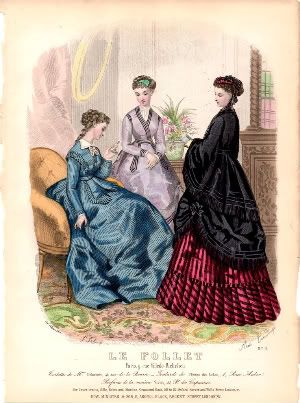
Larger image
*Information is from the ebay listing.
Purchased on ebay as a loose fashion plate, December 2010.
This comes from the British edition of Le Follet. The artist is Anais Colin Toudouze, who became from a family of artists and lithographers.* I do not have a description of the fashions depicted.

Larger image
*Information is from the ebay listing.
Purchased on ebay as a loose fashion plate, December 2010.
Plates from Godey’s Lady’s Book, March, 1885
Every collection starts somewhere. My somewhere happened to be the March 1885 issue of Godey’s Lady’s Book. I bought this from Abe Books in November 2010. I can’t say that this is the sort of thing I imagined I’d ever collect. I always figured I might end up collecting issues of Vogue from the fifties or sixties –which, to this day, I don’t own a single copy- but nineteenth century magazines? It never occurred to me until I developed an interest in fashion plates.
Being a fan of all things vintage and antique, I really love looking through this, even though I’m a bit scared of handling such old paper. The content is amusing, if a little sad. Looking at the ads for lotions that cure all sorts of skin blemishes and the medicines that cure all feminine maladies, you can see the Victorians weren’t so different from us. They too were impatient, looked for instant and magic cures, and were troubled by their own imperfections.
As for fashion plates, there is one color print. I have to admit this scan isn’t the best since it was difficult to get this on my scanner without tearing the binding. In fact, I did tear the binding a bit, and it still came out like this:
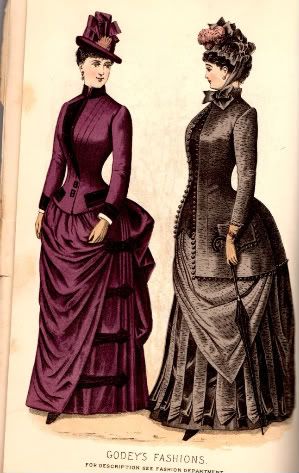
Larger image
It’s a bit Spartan as far as color fashion plates go –nothing elaborate, no background even – but I have to say the skirt of the black dress is lovely. It looks really simple until you realize there are yards and yards of ribbon there. I also love the expression on that lady’s face. She looks like she has heard some delightful bit of gossip from the seemingly prim woman.
Here’s the fashion description from the back of the magazine:
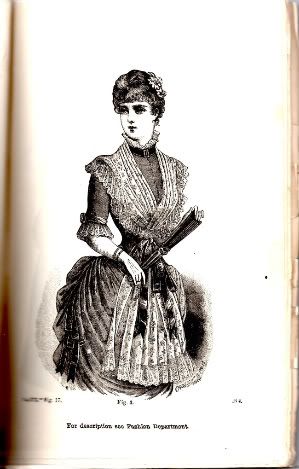
Larger image here
Here’s the description from the fashion pages:

Larger image
The next two prints are a bit of a yawn, in my opinion, so I’m including them solely as a fashion history lesson. First we have women in bustles, features, and high necks. Why ever did this ensemble go out of fashion? I cannot imagine.
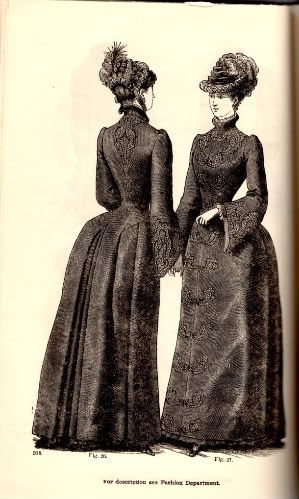
Larger print
And we have more bustles! And more feathers!
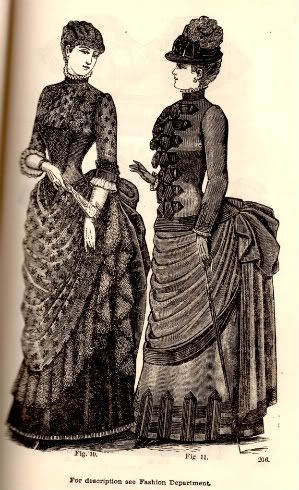
Larger image
Description from the fashion pages:
I don’t think I understood half of figure 10’s description. But there you go: The best of American fashion circa 1885.
Being a fan of all things vintage and antique, I really love looking through this, even though I’m a bit scared of handling such old paper. The content is amusing, if a little sad. Looking at the ads for lotions that cure all sorts of skin blemishes and the medicines that cure all feminine maladies, you can see the Victorians weren’t so different from us. They too were impatient, looked for instant and magic cures, and were troubled by their own imperfections.
As for fashion plates, there is one color print. I have to admit this scan isn’t the best since it was difficult to get this on my scanner without tearing the binding. In fact, I did tear the binding a bit, and it still came out like this:

Larger image
It’s a bit Spartan as far as color fashion plates go –nothing elaborate, no background even – but I have to say the skirt of the black dress is lovely. It looks really simple until you realize there are yards and yards of ribbon there. I also love the expression on that lady’s face. She looks like she has heard some delightful bit of gossip from the seemingly prim woman.
Here’s the fashion description from the back of the magazine:
Fig. 1.-Walking dress of camel’s hair; the skirt is plaited on the left side. Full tunic, open at the left to show the plaiting, and fastened across with straps and buckles, the front being arranged in loose folds; bouffant in the back. Marguerite bodice, trimmed with pockets and revers of velvet. Coat sleeve, velvet cuff. Velvet hat, trimmed with velvet loops and small wing.
Fig. 2.-Walking costume for lady; the skirt is made of velveteen, trimmed with longitudinal bands of satin, divided by straight tabs of brouche wool goods, plaited up at the bottom; a pointed drapery falls over it, with a straight drapery in the back. Long coat with velveteen vest, trimmed with small silk drops; the sleeves and pockets are trimmed to correspond. Velvet bonnet, trimmed with shrimp pink feathers.As for black and white illustrations, here is a vaguely exasperated looking Victorian with a fan. Is it me or does she look like she’s itching to hit someone with it?

Larger image here
Here’s the description from the fashion pages:
Fig. 3.-Evening costume for a young lady. The dress is of pink satin surah, with polonaise looped high upon the sides with loops, and ends of black velvet ribbon, high in the throat, with collar of black velvet; elbow sleeves trimmed with black velvet band and bow, with white lace falling below. Fichu made of piece embroidered Portuguese net, edged all around with trimming lace and fastened with black velvet loops and ends.Have you wondered what hat you should buy next? Well, if so, this next illustration will be of absolutely no use to you unless you are Mrs. Rachel Lynde. (If you are Mrs. Rachel Lynde, please do stop by. I have some “raspberry cordial” I would love to share with you.)

Larger image
The next two prints are a bit of a yawn, in my opinion, so I’m including them solely as a fashion history lesson. First we have women in bustles, features, and high necks. Why ever did this ensemble go out of fashion? I cannot imagine.

Larger print
Figs. 26 and 27.-Back and front view of wrap made of black satin merveilleux; the front is ornamented with jet embroidery, also the back of bodice and sleeves, with are large and lined with satin. Black lace bonnet embroidered with jet and trimmed with satin and feathers. Hat of black felt trimmed with velvet and feathers.
And we have more bustles! And more feathers!

Larger image
Description from the fashion pages:
Fig. 10.-Evening or Dinner dress; skirt of prune velvet, edged with a beige satin baloyense. Tablier of beige and prune shot silk, edged with lace; back drapery of prune satin surah. Satin surah corsage, with lace plastron, cut square at the neck and filled in with a broche chemisette. Broche sleeves with satin surah and lace cuff.
Fig. 11.-Walking dress of mushroom-colored wool goods. The underskirt is plain, trimmed with two rows of wide hercules braid, with double pointed piece at intervals. The overskirt is draped high upon the sides; long and square in the back, trimmed with braid. Jacket-bodice trimmed with braid around the edge, and rows up the front, buckled across with hanging ends; collar and sleeves trimmed with braid. Hat of felt, trimmed with velvet and feathers.
I don’t think I understood half of figure 10’s description. But there you go: The best of American fashion circa 1885.
Subscribe to:
Posts (Atom)
